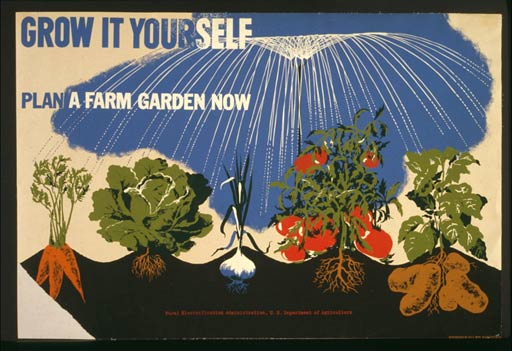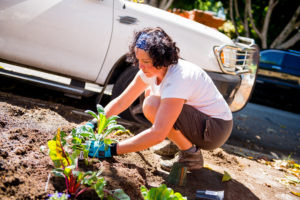How To Plant Your Edible Parkway Garden
0September 4, 2013 by Hope Gardens
Lobelia & Romaine Lettuce
10 Tips for Planting Your Edible Parkway Garden
On Tuesday, August 13th the L.A. City Council approved 15 to 0, “to immediately suspend enforcement of Municipal Code Section 56.08(e) in those cases where parkways are being occupied by vegetables, until a comprehensive report on this matter is presented to the Council.”
This is great news to those looking to repurpose their parkways (the area between the street and the sidewalk) and to those who want to grow vegetables on their property. Previously, citations were given to neighborhood gardeners who did not draw a permit before planting anything other than sod on their parkway. Take advantage of this exciting opportunity and plant your own vegetable garden with these 10 Edible Parkway Garden Tips.
1. Follow the basics of the city’s Residential Parkway Landscaping Guidelines (RPLG).
The City Council has suspended issuing citations while in the process of re-writing these guidelines. It is safe to assume the new guidelines will retain some of the existing parkway requirements, so it behooves us to keep their basic regulations in mind. One of these old guidelines worth considering is the need for a “convenience strip.” (There is some lingo to learn here…hey, you’ve learned “parkway.”)
A “convenience strip” is the 18” deep strip of parkway that runs parallel to the street. This is to enable passengers of cars to exit their parked vehicle safely and without damaging your plants. The strip needs to be a material that can be walked on and flush with the top of the curb. It can be paved, planted with turf or turf substitutes, or covered with mulch or stone.
Another term to know is “house walk.” This is a 48” wide connector between the street and the sidewalk. It should be installed wherever there is in a continuous strip of planted parkway in excess of 50’ long. The RPLG recommends the house walk be paved, but I think for now a layer of mulch or stone will be a good temporary plan. This walk allows pedestrians access street to the sidewalk and protects your plants from harm.
2. Plant your parkway vegetable garden in raised beds.
This will keep your garden safe from erosion and pedestrians. You can purchase pre-made raised beds, raised bed kits or build your own from redwood or cedar. Raised beds need to be at least 12” deep to plant the widest variety of vegetables. Herb & greens/lettuce beds can tolerate a depth of just 9” . Depending on the size of your parkway, I would shoot for a container between 2-4’ wide and 4’-8’ long. If you choose to plant in-ground, be especially aware of the next point.
Rainbow Swiss Chard
3. It’s all about the soil.
Whether you plant in-ground or in raised beds, the quality of your soil is the most important indicator of success for nutritious, healthy plants.
First, turn over your soil. You want to dig down at least 12 inches. Discard debris, weeds, roots, rocks and cutworms. Work the soil between your gloved fingers to break up clods of dirt. This is a lot of work but essential to a healthy garden.
You need to pay special attention if you are growing root vegetables, like carrots or beets, as they require a soil-medium free of obstructions. Otherwise you will have bent, pock-marked and/or diseased veggies and you won’t know it until you pull them out. This is also important work if you want to plant your veggies by seed.
Your best soil will be a combination of growing medium (potting soil in beds, native soil in-ground), micro-organisms (compost) and natural fertilizers. I use an organic vegetable fertilizer along with some extra bone meal and blood meal.
4. Consider a fence.
When considering a fence, consider the interloper. First and foremost, on a parkway, you want pedestrians to be able to see your garden and not walk into it, so a fence at least 2’ high is almost a necessity. This is especially true if you are planting in-ground.
A 3’ fence will also keep your garden visible and will have the added benefit of keeping out rabbits, possums, raccoons and cats. You can try a simple push-in panel fence or use posts with plastic or metal chicken wire. Growing a pretty vegetable or flower on your fence, like sugar snap peas or nasturtium, will keep these fences attractive.
Sugar Snap Peas
5. Keep your turf.
You can keep the grass or plantings you have growing currently and only remove the turf where you want your veggie garden/raised beds to be. This can save you a lot of time and money in the short term. You can mulch 6”-12” around your vegetable bed with wood chips and/or large rocks to provide a barrier between the grass and the garden.
6. Keep your irrigation.
For now, if your sprinkler heads are working, you can leave your irrigation where it is. Overhead sprinklers get a bad rap. While they can be wasteful if not set properly, they are totally fine for watering veggies with.
Check that the sprinklers on your parkway are properly directed and properly timed. Watering in the morning is better than the evening to deter powdery mildew. The alternative to the overhead sprinkler is the low-water emitter. The city is actually offering a rebate for replacing your sprinkler heads with more precise rotating nozzles. Many present sprinkler systems can be easily adapted to use these nozzles.
For vegetable gardens, I warn against soaker hoses or drip systems. These systems tend to be installed incorrectly and not allowed to run long enough to truly hydrate the plant.
Veggies need to have their whole root base watered. To get that much water out of a soaker or drip you have to run the water for 20 plus minutes. Most of us have our irrigation systems connected to other areas of our yard and those other areas do not often benefit from running for 20 minutes…nor does our water bill. So before you change out your sprinkler heads, make sure you have a good understanding of your irrigation as a whole.
Another reason to rethink drip systems, seeds need a moist environment to germinate in. Soakers and drip systems can water deep, but they don’t keep the top of the soil wet the way a sprayer or nozzle does. Don’t be afraid to hand water your garden, even if you have a timed irrigation system. Plants benefit greatly from a simple spray with the hose.
Borage
7. Plant beneficial flowers.
There is no reason a vegetable garden has to be an eyesore. Flowers are a wonderful addition to any vegetable garden and a necessary one at that.
A bee needs to visit a flower 7-8 times to pollinate it so you need to do all you can to draw that pollinator to your vegetables time and time again. Flowers also have the ability to attract other beneficial insects and deflect those bugs who are less than beneficial.
I especially encourage the use of the herb Borage. It is a cinch to grow from seed and re-seeds like crazy. It grows big, so give it lots of room…think the very end of your garden, and it might need staked.
Borage is uber-compatible to vegetable plants, repels the tomato hornworm, is a bee magnet, and blooms with beautiful, blue, edible flowers; the essence of which brings courage. What’s not to love?
In addition, there are many plants already approved for use in the parkway which would be beneficial to vegetable growing.
Yarrow (Achillea millefolium) is drought-tolerant, a CA native, medically useful in numerous ways, a bee attractor and a repeller of harmful insects.
Chamomile groundcover (Chamaemelum nobile) offers natural pest protection as well as being reputed as a “plant doctor,” pumping up the health of nearby plants.
Lippia (Phyla nodiflora) is a CA native that attracts bees and makes a great groundcover, handling a good deal of trampling. It’s evergreen and produces pretty flowers. Pretty flowers always have a place in the vegetable garden.
Creeping Thyme (Thymus praecox) is a fragrant, hardy herb that attracts bees and butterflies and only needs moderate water.
8. Pick seasonal vegetables.
Presently, we are heading into fall and that is the wonderful but sometimes forgotten “second season” of vegetable gardening. We turn to greens: lettuce, arugula, collards, kale and chard. Broccoli is a delicious and easy vegetable along with the root vegetables previously discussed like carrots, radishes, parsnips, beets and rutabaga. You can also get strawberries going this time of year. Pair it with spinach for greater production. Planting herbs, chives, onion and garlic keeps pests away and provides instant seasoning for your favorite dishes. And don’t forget the sugar snap peas. A nice teepee of bamboo will allow them to climb towards the sun and sweeten on the vine. A kid favorite!
When in doubt, first time gardeners should try seedlings bought from reputable nurseries. Seeds need special care: proper watering, germination, thinning, but that being said, every gardener takes a profuse pride in growing their own food from seed. Carrot, radish, lettuce and sugar snap peas are, dare I say, foolproof from seed. Take this time between seasons to peruse an heirloom seed catalog online and let your imagination run wild.
9. Maintain. Maintain. Maintain.
Gardening is not for the weak of heart. Especially vegetable gardening. Your plants will wither, rot, falter and fail to thrive. Bugs will wipe you out in a day. But if you truly want the yummy, nutritious, organic and beautiful garden of your dreams, you have to be vigilant caretaker.
Aside from providing your plants with a healthy soil, a great way to secure your garden’s success, is to spend time in your garden. Examining. Pruning. Weeding. Trimming. Fertilizing. Foliar feeding. Treating disease and pests. Staking vines. Aerating soil. Harvesting. And re-planting.
I recommend spending an hour in your garden once a week. Time spent now, will save you more time spent later. It’s easier to head off a small problem, then to try to fix a big one. Prevention, in organic gardening, is the cure.
10. Enjoy your garden.
Don’t forget enjoying. We can get caught up in the end game. We have our sights on that perfect pint of sweet strawberries. Or a bushel of brussels. However you may end up with gorgeous chard and a bumper crop of snap peas. Managing your expectations is as much a part of urban farming as tilling your soil. Allow your garden to show itself to you. Allow your microclimate to produce what comes easily and best and most beautifully. Enjoy the process: watch the bees and butterflies, delight in small things, be thankful for the opportunity provided to us neighborhood garden warriors and most of all, find joy in your results, whatever they may be. And watch your garden thrive.
While Eric Garcetti and the LA City Council rewrite the parkway planting guidelines, let us as a proud city put our creative juices into making the prettiest, the most water-conscious, the very best community-building parkways in the country. I like the sound of “most edible-gardens-per-capita.” Post a photo of your inspiring edible parkway garden here. And…enjoy your garden!
[pinterest count=”horizontal”]
Category Vegetable gardening | Tags: Compost, edible garden, Garden, Genetically modified organism, GREENS, Harvest, Home, Home garden, Los Angeles, organic, parkway, pea, Plant, raised bed, raised bed garden, raised garden bed, recipe, Seed, Snap pea, Soil, Square foot gardening, summer, Vegetable, Vegetable Garden



